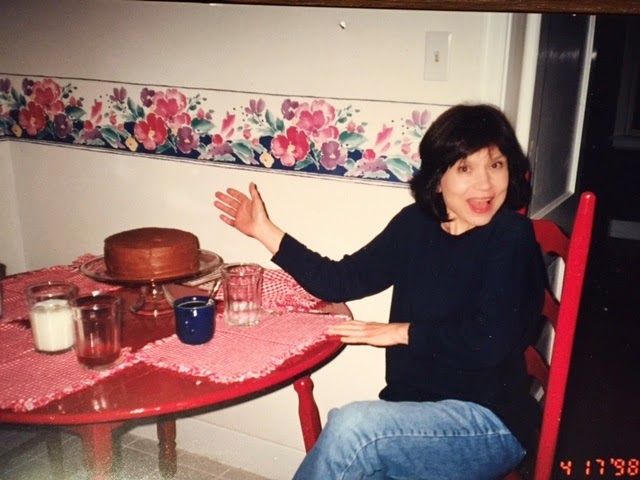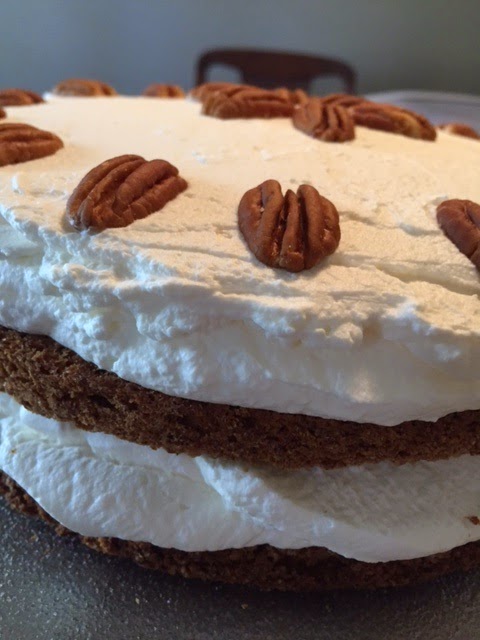
 |
| Ad on reverse of clipping |
Housekeeping In Old Virginia contains many gems among the recipes; tips on butchering and the storage of meat without an ice house, and how to take quinine without tasting it. Some recipes are confounding in their apparent simplicity and this is the case with the "Robert E. Lee" Cake, submitted by "Mrs. G." The recipe in its entirety:
Twelve eggs, their full weight in sugar, a half-weight in flour. Bake it in pans the thickness of jelly cakes. Take two pounds of nice "A" sugar, squeeze into it the juice of five oranges and three lemons together with the pulp; stir it in the sugar until perfectly smooth; then spread it on the cakes, as you would do jelly, putting one above the other till the whole of the sugar is used up. Spread a layer of it on top and on sides.A compelling recipe challenge! After determining, from other recipes in the book, that jelly cakes are round layer cakes. I set about deciphering the term "nice A sugar." From what I was able to find on the internet, "A" sugar was a term for white granulated sugar. Three ingredients in a cake with eggs as the only leavening agent, then iced with a filling that is fruit juice and sugar? Could "A" sugar in 1897 be fine like a caster sugar? How much pulp?

 The cake was no problem. It smelled egg-y during the baking and it rose high and even. The filling was less successful. Instead of stirring by hand while wearing a late Victorian corset and layers of skirts in a hot southern kitchen with no air conditioning, I used a Kitchen Aid to stir. It took quite a while to dissolve the sugar and then I had sugary citrus juice that would never cling to a cake enough to use as a filling between the
The cake was no problem. It smelled egg-y during the baking and it rose high and even. The filling was less successful. Instead of stirring by hand while wearing a late Victorian corset and layers of skirts in a hot southern kitchen with no air conditioning, I used a Kitchen Aid to stir. It took quite a while to dissolve the sugar and then I had sugary citrus juice that would never cling to a cake enough to use as a filling between the 
 layers much less on the sides. I added more sugar and it turned grainy. I gently heated the juice and lost the bright citrus flavor while not improving the texture.
layers much less on the sides. I added more sugar and it turned grainy. I gently heated the juice and lost the bright citrus flavor while not improving the texture.So, I started over on the filling. I tried using more pulp to add some more structure and more pectin to the mix. I sectioned the oranges and lemons and retained the juice with the pulp. This helped, but the texture was still only as thick as pancake syrup. It was still a little grainy. I set about icing the cake, juggling the runny filling as fast as I could. Much of the juice soaked into the cake, leaving a coating of citrus pulp on the outside. The results are interesting. The citrus flavor interacts nicely with the egg-laden cake. The cake is moist and light with a thin, crunchy crust. The texture of the filling is still strange and a little grainy. If I make a "Robert E. Lee" cake again, I will make it with orange/lemon curd filling similar to Lemon Cheese Cake (see March 7).
A recipe for "Robert E. Lee" cake, out of a cookbook from Old Virginia demanded to be made for Confederate Memorial Day, April 26. I, like most native southerners, have Confederate veterans in my family tree. Papa's mother, Sarah Angeline Sells Page, was an diminutive adolescent at the time of the war and she was a spy for the Confederacy. She only stood 4'11" as a full-grown woman and during the war she was dressed as a young child and sent across enemy lines with maps and communiques secreted inside the body of her doll. On my father's side, Granna's grandfather, Jefferson Smith, was a sharpshooter (sniper) in General Gordon's brigade.
Despite the fascinating Confederate history I have in my bloodline, our family never commemorated Confederate Memorial Day. I don't remember special parades, commemorative services at cemeteries or even any mention of the holiday. The way I found out that April 26 is Confederate Memorial Day is that it is also my birthday. On my 16th birthday, my mother checked me out of school early to go to take my driving test and get my license. We arrived at the license office in East Atlanta on Moreland Avenue to find it closed! Georgia state offices were closed for Confederate Memorial Day back in the 1980's.
For my birthday this year, my mother will be making a gluten-free version of my favorite cake, Chocolate-Pineapple Cake. A Chocolate-Pineapple Cake is the creation of Mama Judy's sister, Daisy Allgood Babb (called Aunt Whick, mother to Pat, Betty, Jackie). It is a four-layered, 1-2-3-4 cake with tangy pineapple curd between the layers and dark chocolate buttercream frosting on the outside. My mother has made this family delicacy for me for almost every birthday. I cannot wait for tomorrow. We'll have both a gluten-free cake and a citrus-y experiment of a cake for my birthday celebration!
 |
| My mom with my birthday cake in Jackson, Mississippi at my first house (before I removed that terrible wallpaper) |
Now, if someone could give me an early birthday present and help me clean all of the sticky fruit juice and sugar out of my kitchen...
Next Saturday: Mexican Chocolate Cake


















